First, Manufacturer's Specifications:
• Cree XM-L (T6) LED with a lifespan of 50,000 hours
• Uses four 3V CR123A batteries (Lithium) or two 18650 rechargeable batteries (Li-ion)
• 164mm (Length) x 43.64mm (Diameter) x 51.5mm (Head)
• 256-gram weight (excluding batteries)
• Digitally regulated output - maintains constant brightness
• Reverse polarity protection, to protect from improper battery installation
• Dual button switch in the tail cap, convenient operation
• Made of durable aircraft-grade aluminum
• Premium Type III hard-anodized anti-abrasive finish
• Toughened ultra-clear glass lens with anti-reflective coating
- Six levels of output:
- Turbo - 820 lumens, 1 hour 33 minutes
- High - 346 lumens, 5 hours 6 minutes
- Mid - 109 lumens, 16 hours
- Low - 12 lumens, 170 hours
- Strobe - 820 lumens
- SOS - 109 lumens
- Distance - 333m


The packaging is typical of Fenix (ie cardboard box with plastic insert). Inside you will find the light, manual, warranty card, wrist strap and belt holder.
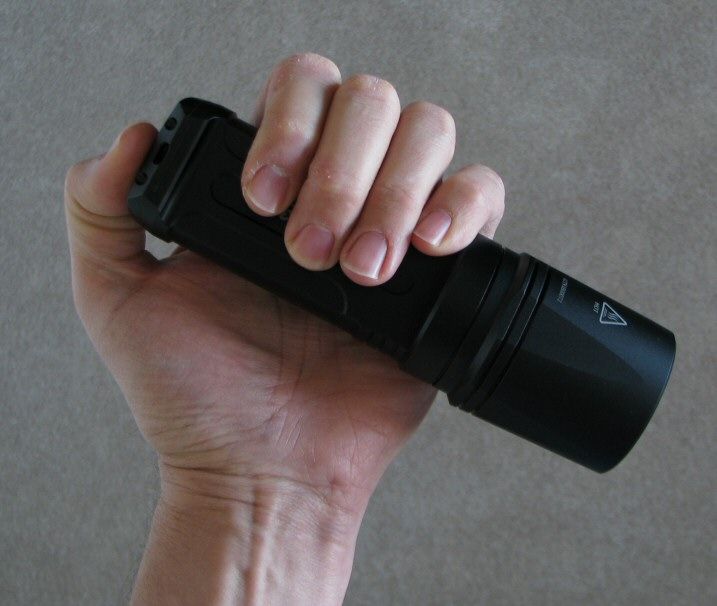

From left to right: AW Protected 18650, TK35, Sunwayman M40C, Eagletac M3C4 XM-L, Fenix TK45, Lumintop TD15-X.
All dimensions are given without the batteries:
TK35: Weight 256.1g, Length 162mm, Width (bezel): 48.6mm, Max Wdith 52.0mm
M40C: Weight: 258.5g, Length 156mm, Width (bezel) 57.1mm,
M3C4 XM-L: Weight: 348.0g, Length: 164mm, Width: 61mm (bezel)
M3C4 SST-50 SMO-Deep: Weight: 354.2g, Length: 165mm, Width: 61mm (bezel)
M3C4 SST-50 OP: Weight: 334.7g, Length: 158mm, Width: 61mm (bezel)
As you can see, the TK35 is one of the most compact offering in the side-by-side 2x18650 class of lights.


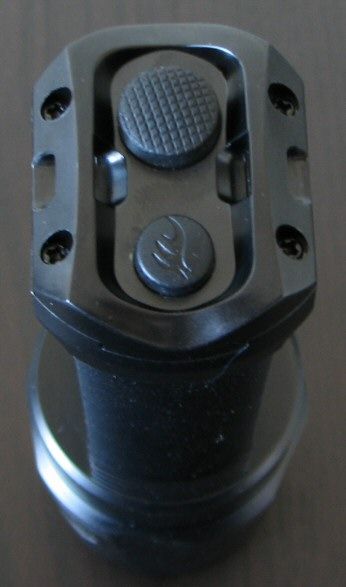



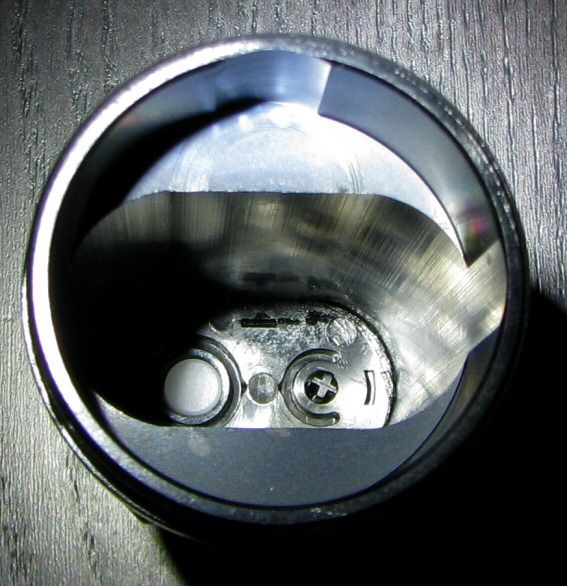



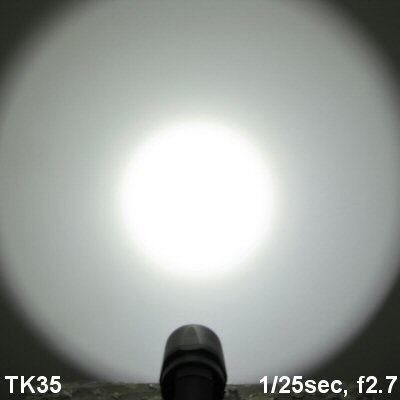
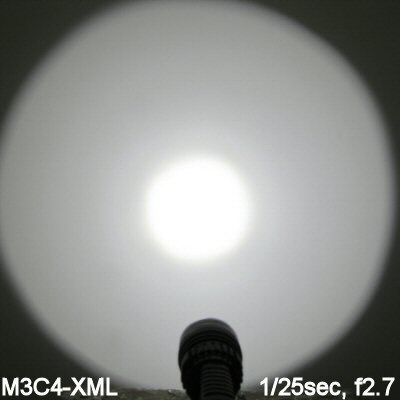
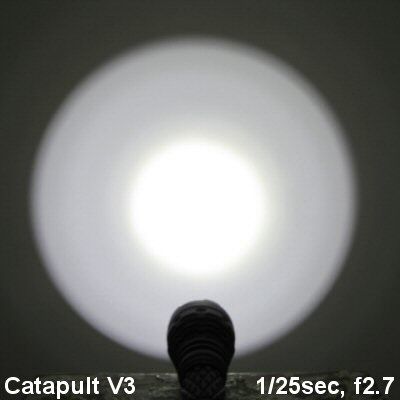


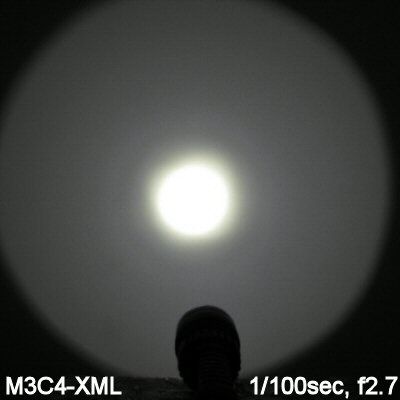


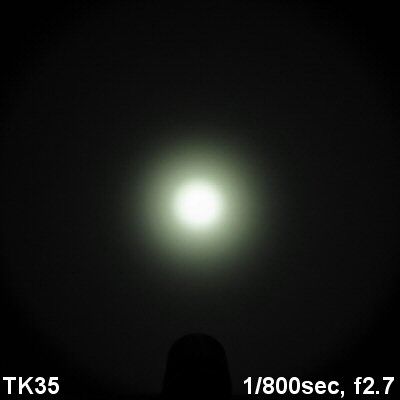
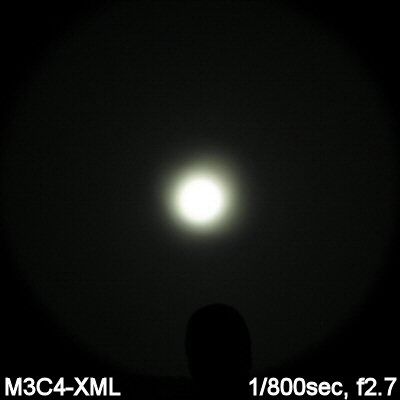



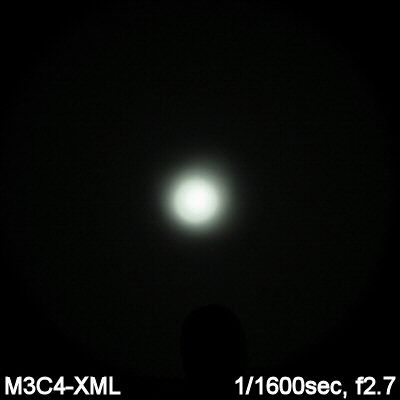
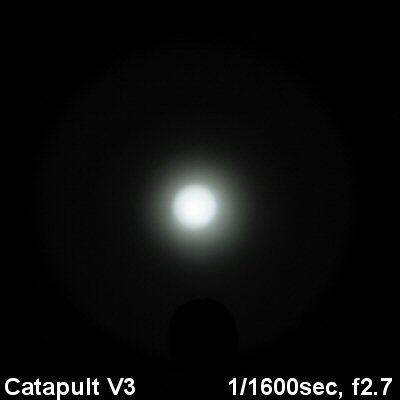
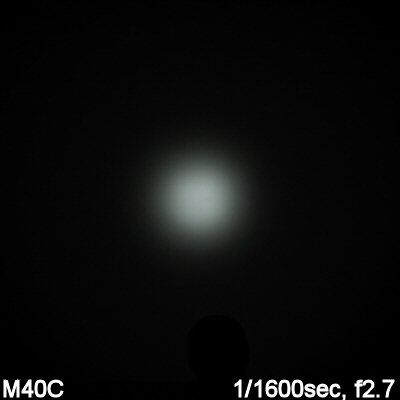
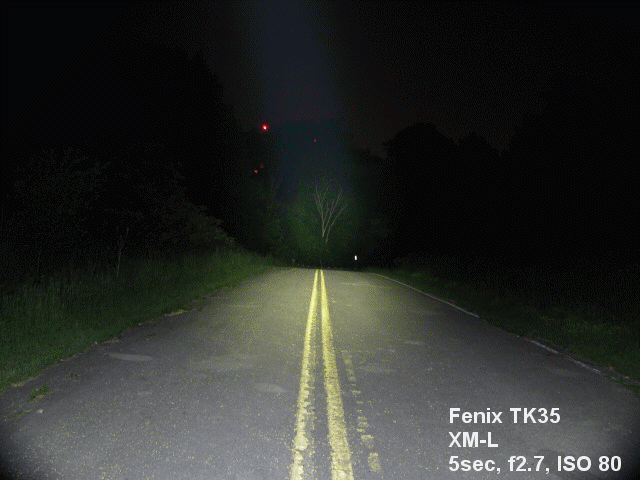
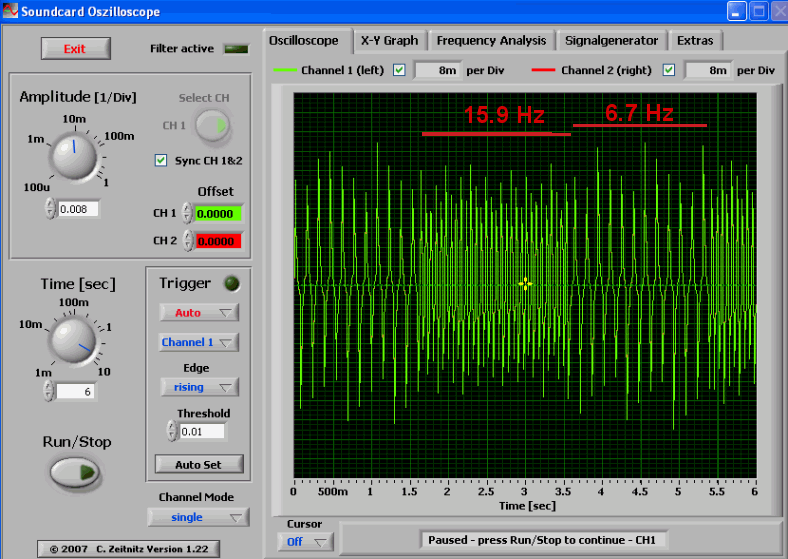
Strobe is an oscillating strobe, switching between 6.7 Hz and 15.9 Hz at ~1.8 sec intervals on my sample.
Testing Method:
All my output numbers are relative for my home-made light box setup, a la Quickbeam's flashlightreviews.com method. You can directly compare all my relative output values from different reviews - i.e. an output value of "10" in one graph is the same as "10" in another. All runtimes are done under a cooling fan, except for any extended run Lo/Min modes (i.e. >12 hours) which are done without cooling.
I have recently devised a method for converting my lightbox relative output values (ROV) to estimated Lumens. See my How to convert Selfbuilt's Lighbox values to Lumens thread for more info.
Throw/Output Summary Chart:
Effective November 2010, I have revised my summary tables to match with the current ANSI FL-1 standard for flashlight testing. Please seehttp://www.sliderule.ca/FL1.htm for a description of the terms used in these tables.
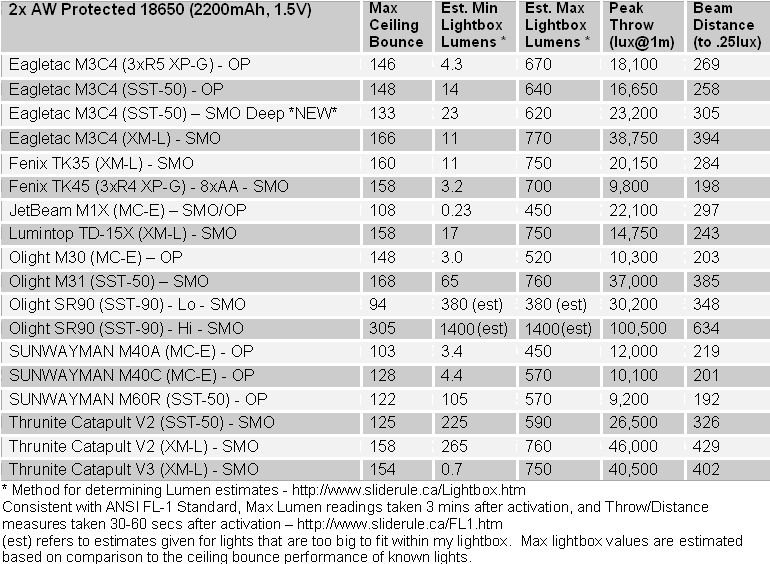
Output on max is very comparable to my other recent XM-L based lights, like the Eagletac M3C4, Thrunite Catapult V3 and Lumintop TD15-X. As expected, peak throw/beam distance is less than the larger M3C4 and Catapult V3 lights (with their larger and deeper reflectors), but is greater than the smaller TD15-X. Throw is basically in the traditional range of most of the larger SST-50-based lights.
Lo output is reasonable for this class – not as low as some earlier Fenix lights, but in keeping with most of the recent XM-L lights.
Output/Runtime Comparison:
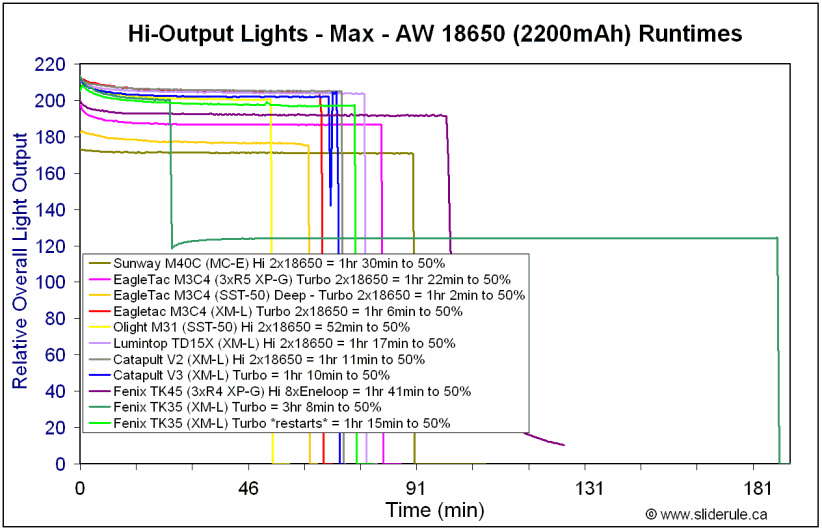
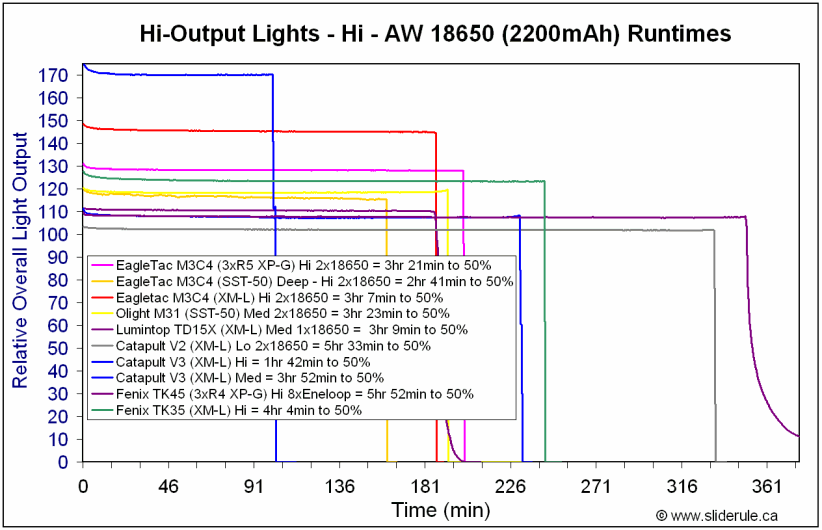

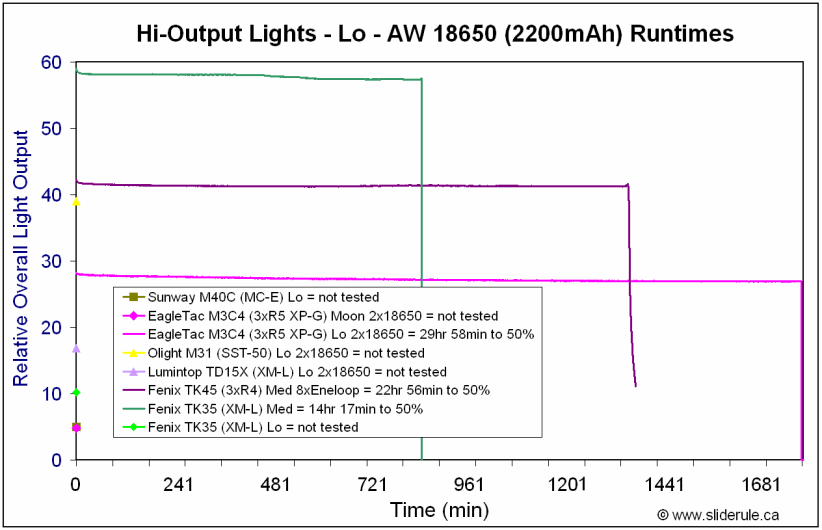
I have only done 2x18650 runtimes, but the light can also handle 4xCR123A. As you can see, output/runtime efficiency is certainly in keeping with other current-controlled lights with XM-L emitters – and perhaps even a touch better on my TK35 sample.
You will also note the interesting runtime pattern on Turbo. After exactly 25 mins, the light drops to Hi for the rest of the run (i.e. the first TK35 trace on my Max 18650 graph). This is not a thermal sensor, but a timed drop-down feature. To allow you to better compare to other lights that remain constant, I flashed the TK35 off-on every 20 mins in the second run, so you can see what happens if you keep it going (i.e. labelled as "*restarts*" in the first graph legend).
Potential Issues
As always, I have some concerns over long-term stability with any all-plastic battery carrier. Although the TK35 carrier seems better than their previous offerings in the high-output class, the dual switch control area feels relatively cheap. In particular, the simple plastic plunger that connects to electronic switch does not inspire a lot of confidence (it also rattles at all times).
The heavily green tint on my sample suggests that Fenix is using non-premium cool white tints for this line. This would be in keeping with the lower than typical price.
Light lacks any real knurling, and can be more slippery than most in this class.
Holster and wrist lanyard are fairly basic, but at least they are both provided (which is more than some manufacturers).
Preliminary Observations
In many ways, the TK35 is something of a Goldilocks model. Build-wise, you could argue that most of the other high-output lights are either too long, too thick, too heavy, or too light. The TK35 feels just about right in the hand – nice and compact, and well-balanced.
Same goes for the beam pattern. No, it is not a huge thrower for the XM-L class – but it throws as well as the much larger SST-50-based lights, and better than all the earlier MC-E ones. No, it doesn’t have a huge spillbeam width, like lights with massively wide heads. Instead, it has a very well balanced beam profile that suits most general uses.
I think the dual control interface is generally well implemented. You can easily use the light in over-hand tactical grip without having to re-position (i.e. buttons are easy to differentiate). I would have liked to have been able to set the output level before activation, but that would have required a major redesign (and likely necessitated a standby current drain in this dual switch setup).
Of course, one area where you can always expect Fenix to excel is in overall output/runtime efficiency. No surprises here – the TK35 does as well (and perhaps slightly better) in overall efficiency as any other current-controlled light in the XM-L class. The 25 min drop-down feature on Turbo is interesting (and likely a good safety feature), but you can always circumvent it if you need to by turning off/on again. And max output is consistent with all the recent XM-L lights I’ve tested.
Another distinctive feature of the TK35 is the price. I don’t normally comment on this in my reviews, but it is remarkably low considering everything you are getting here (i.e. ergonomics, performance, and the reassurance of an established brand name).
So, with all that going for it, sounds like slam-dunk right? Well, not necessarily. That low cost brings a few less desirable aspects with it. As mentioned above, I don’t like all-plastic battery carriers (although this one is better than most). But I do find the switching control area has a rather cheap feel, and I worry about its long-term stability.
The other cost issue is tint. There are never any guarantees here – but some makers do pay extra to insure specific “premium” cool white tint bins are used. In my experience, Fenix doesn’t typically do this (although to be fair, they are also a much higher volume manufacturer, and therefore have to go with what’s available). I bring this up only because my TK35 sample has the most greenish tint that I’ve ever seen in all my flashlight testing. What this suggests to me is that you can therefore expect a very wide range of possible tints on the TK35 – caveat emptor.
And although I like the body design (and the nice touches like anodized square threads, etc.), I would also like to see some actual knurling on the light to improve grip. Probably one of the best builds I’ve seen in this size light is the Sunwayman M40C – an even more compact side-by-side 2x18650 design, dual interface with magnetic control ring, all-metal carrier, etc. But it uses the older MC-E emitter and as is still ~50% more expensive.
At the end of the day, I think the TK35 is a fantastic bargain with a good overall design, good mix of features and outstanding performance. The build is still not quite everything it could be, but it is certainly still quite acceptable - you just need to have realistic expectations for the price. And honestly, I don’t see how you could do much better at this price point for a high-output light, at the current time.
M3C4 XM-L: Weight: 348.0g, Length: 164mm, Width: 61mm (bezel)
M3C4 SST-50 SMO-Deep: Weight: 354.2g, Length: 165mm, Width: 61mm (bezel)
M3C4 SST-50 OP: Weight: 334.7g, Length: 158mm, Width: 61mm (bezel)
As you can see, the TK35 is one of the most compact offering in the side-by-side 2x18650 class of lights.



The body plan of the TK35 is very streamlined and very comfortable to hold and handle.
Black anodized (Type III = HA) is dull, with no stains on my sample. Scripture is clear and sharp but not overly bright.
The light is missing knurling as such, but there are a number of small ribs on both sides of the battery handle (similar to the concentric annular ribs on the TK45). While this helps a bit with grip, I still think the TK35 slippery than other lights in its class.
Threads are angular and anodized to allow for head lock-out.
Even if it looks like it should, can not see the light tailstand as easily as the on / off switch bulges slightly on my test (even if on).


The most important property of light is the battery compartment. Made entirely of plastic, it slides completely into the aluminum handle. Other than the TK45, the feathers are used for positive and negative contact on thehead and did not find the vehicle. The carrier chambers hold all of my 18 650 protected cells, and the newer high capacity ones. There is a raised button on the positive in each chamber to work, so flat top cells.
The most special thing is the barrier that contains two different types of switches - a forward clicky on / offactivation, and a secondary electronic switch for changing the mode, as described below.



The switch control mechanism is interesting. At the base of the handle body, you will see two buttons. The smaller this is essentially just a small plastic rod with a rubber tip, which serves as the change of the key. In the assembled state, it makes contact with the actual electronic switch on the battery tube. There is a definite click when changing modes, but the feeling is very different than a traditional clicky.
The larger button is clicky with a conventional on / off switch. Feel is a little stiffer than typical, but is otherwise familiar.
There is definitely a rattle to light, even if it is fully assembled (probably because of the change of the plastic rod). And we must be careful how you pay for the battery carrier - it will only fit one way due to the different switch types.


The TK35 uses the Cree XM-L emitter, with a relatively deep and smooth reflector. There seems to be some very mild texturing applied to the surface, the somewhat clouds the finish (probably helps smooth the beam) to be.
Which brings me to the white wall beam shots. All lights are on protected 2xAW 18650, about 0.75 meters from a white wall ~ (~ 1.25 meters with the camera on the back wall). Automatic white balance on the camera to minimize sound differences.
















First off, this sample was one of the green highlights I have ever seen. The pictures above are all taken with automatic white balance, and are lighter to minimize sound differences. In real life it is more green than it appears at the top.
Light distribution is actually very good - the light has to spill a fair amount of litter, and a nice transition from spot.
6th UPDATE June 2011: I've just written a new 100-yard Round-Up BEAMSHOT contribution for the year 2011, presented all of my current "thrower" lights. Below is an animated GIF shows some relevant comparisons for the TK35. Please note that the round-up review for more pictures of other lights, taken under the same conditions.

User Interface
On / off by the larger forward clicky switch (press-on for momentary, click for locked).
Mode change is controlled by the smaller secondary electronic switch. Click and release to by output modes traveling in the order of lo> Med> Hi> Turbo to promote repetitive sequence. The light has memory mode, and reserves the final level-set, if you turn the lights on again.
Note that you do not level out, while the light is turned off. The electronic switch only works when the light is the switch has power clicky first. As such, there is no standby power to the TK35.
The "hidden" strobe and SOS modes are differentiated by clicking and holding the retrieved electronic switch for more than 1 sec. The light will now be moved between a slow and a fast high-intensity strobe SOS, if you click and release the electronic switch. To return to the constant out-modes, press and hold the electronic switch for longer than 1 second again, or simply turn / on the light.
The flashing modes and a memory, and the light is used, the last mode, if you re-enter this state back - but turns on the light always learn by heart in the constant output voltage mode. Thus, there is no danger of accidentally strobe itself (but not vice versa, you can not strobe on, without having the light in a constant mode).
The light has an interesting security feature - after exactly 25 minutes of continuous runtime on turbo, then it falls down to the level for the rest of the Hello Time is on your left. Turning off / on is the turbo-mode (at least for the next 25 minutes).
PWM / Strobe
There is no sign of pulse width modulation (PWM) on the lo / med / hi-modes, which I can see what me to conclude that light is like most other current-controlled Fenix offerings.

Strobe is an oscillating strobe, switching between 6.7 Hz and 15.9 Hz at ~1.8 sec intervals on my sample.
Testing Method:
All my output numbers are relative for my home-made light box setup, a la Quickbeam's flashlightreviews.com method. You can directly compare all my relative output values from different reviews - i.e. an output value of "10" in one graph is the same as "10" in another. All runtimes are done under a cooling fan, except for any extended run Lo/Min modes (i.e. >12 hours) which are done without cooling.
I have recently devised a method for converting my lightbox relative output values (ROV) to estimated Lumens. See my How to convert Selfbuilt's Lighbox values to Lumens thread for more info.
Throw/Output Summary Chart:
Effective November 2010, I have revised my summary tables to match with the current ANSI FL-1 standard for flashlight testing. Please seehttp://www.sliderule.ca/FL1.htm for a description of the terms used in these tables.

Output on max is very comparable to my other recent XM-L based lights, like the Eagletac M3C4, Thrunite Catapult V3 and Lumintop TD15-X. As expected, peak throw/beam distance is less than the larger M3C4 and Catapult V3 lights (with their larger and deeper reflectors), but is greater than the smaller TD15-X. Throw is basically in the traditional range of most of the larger SST-50-based lights.
Lo output is reasonable for this class – not as low as some earlier Fenix lights, but in keeping with most of the recent XM-L lights.
Output/Runtime Comparison:




I have only done 2x18650 runtimes, but the light can also handle 4xCR123A. As you can see, output/runtime efficiency is certainly in keeping with other current-controlled lights with XM-L emitters – and perhaps even a touch better on my TK35 sample.
You will also note the interesting runtime pattern on Turbo. After exactly 25 mins, the light drops to Hi for the rest of the run (i.e. the first TK35 trace on my Max 18650 graph). This is not a thermal sensor, but a timed drop-down feature. To allow you to better compare to other lights that remain constant, I flashed the TK35 off-on every 20 mins in the second run, so you can see what happens if you keep it going (i.e. labelled as "*restarts*" in the first graph legend).
Potential Issues
As always, I have some concerns over long-term stability with any all-plastic battery carrier. Although the TK35 carrier seems better than their previous offerings in the high-output class, the dual switch control area feels relatively cheap. In particular, the simple plastic plunger that connects to electronic switch does not inspire a lot of confidence (it also rattles at all times).
The heavily green tint on my sample suggests that Fenix is using non-premium cool white tints for this line. This would be in keeping with the lower than typical price.
Light lacks any real knurling, and can be more slippery than most in this class.
Holster and wrist lanyard are fairly basic, but at least they are both provided (which is more than some manufacturers).
Preliminary Observations
In many ways, the TK35 is something of a Goldilocks model. Build-wise, you could argue that most of the other high-output lights are either too long, too thick, too heavy, or too light. The TK35 feels just about right in the hand – nice and compact, and well-balanced.
Same goes for the beam pattern. No, it is not a huge thrower for the XM-L class – but it throws as well as the much larger SST-50-based lights, and better than all the earlier MC-E ones. No, it doesn’t have a huge spillbeam width, like lights with massively wide heads. Instead, it has a very well balanced beam profile that suits most general uses.
I think the dual control interface is generally well implemented. You can easily use the light in over-hand tactical grip without having to re-position (i.e. buttons are easy to differentiate). I would have liked to have been able to set the output level before activation, but that would have required a major redesign (and likely necessitated a standby current drain in this dual switch setup).
Of course, one area where you can always expect Fenix to excel is in overall output/runtime efficiency. No surprises here – the TK35 does as well (and perhaps slightly better) in overall efficiency as any other current-controlled light in the XM-L class. The 25 min drop-down feature on Turbo is interesting (and likely a good safety feature), but you can always circumvent it if you need to by turning off/on again. And max output is consistent with all the recent XM-L lights I’ve tested.
Another distinctive feature of the TK35 is the price. I don’t normally comment on this in my reviews, but it is remarkably low considering everything you are getting here (i.e. ergonomics, performance, and the reassurance of an established brand name).
So, with all that going for it, sounds like slam-dunk right? Well, not necessarily. That low cost brings a few less desirable aspects with it. As mentioned above, I don’t like all-plastic battery carriers (although this one is better than most). But I do find the switching control area has a rather cheap feel, and I worry about its long-term stability.
The other cost issue is tint. There are never any guarantees here – but some makers do pay extra to insure specific “premium” cool white tint bins are used. In my experience, Fenix doesn’t typically do this (although to be fair, they are also a much higher volume manufacturer, and therefore have to go with what’s available). I bring this up only because my TK35 sample has the most greenish tint that I’ve ever seen in all my flashlight testing. What this suggests to me is that you can therefore expect a very wide range of possible tints on the TK35 – caveat emptor.
And although I like the body design (and the nice touches like anodized square threads, etc.), I would also like to see some actual knurling on the light to improve grip. Probably one of the best builds I’ve seen in this size light is the Sunwayman M40C – an even more compact side-by-side 2x18650 design, dual interface with magnetic control ring, all-metal carrier, etc. But it uses the older MC-E emitter and as is still ~50% more expensive.
At the end of the day, I think the TK35 is a fantastic bargain with a good overall design, good mix of features and outstanding performance. The build is still not quite everything it could be, but it is certainly still quite acceptable - you just need to have realistic expectations for the price. And honestly, I don’t see how you could do much better at this price point for a high-output light, at the current time.





